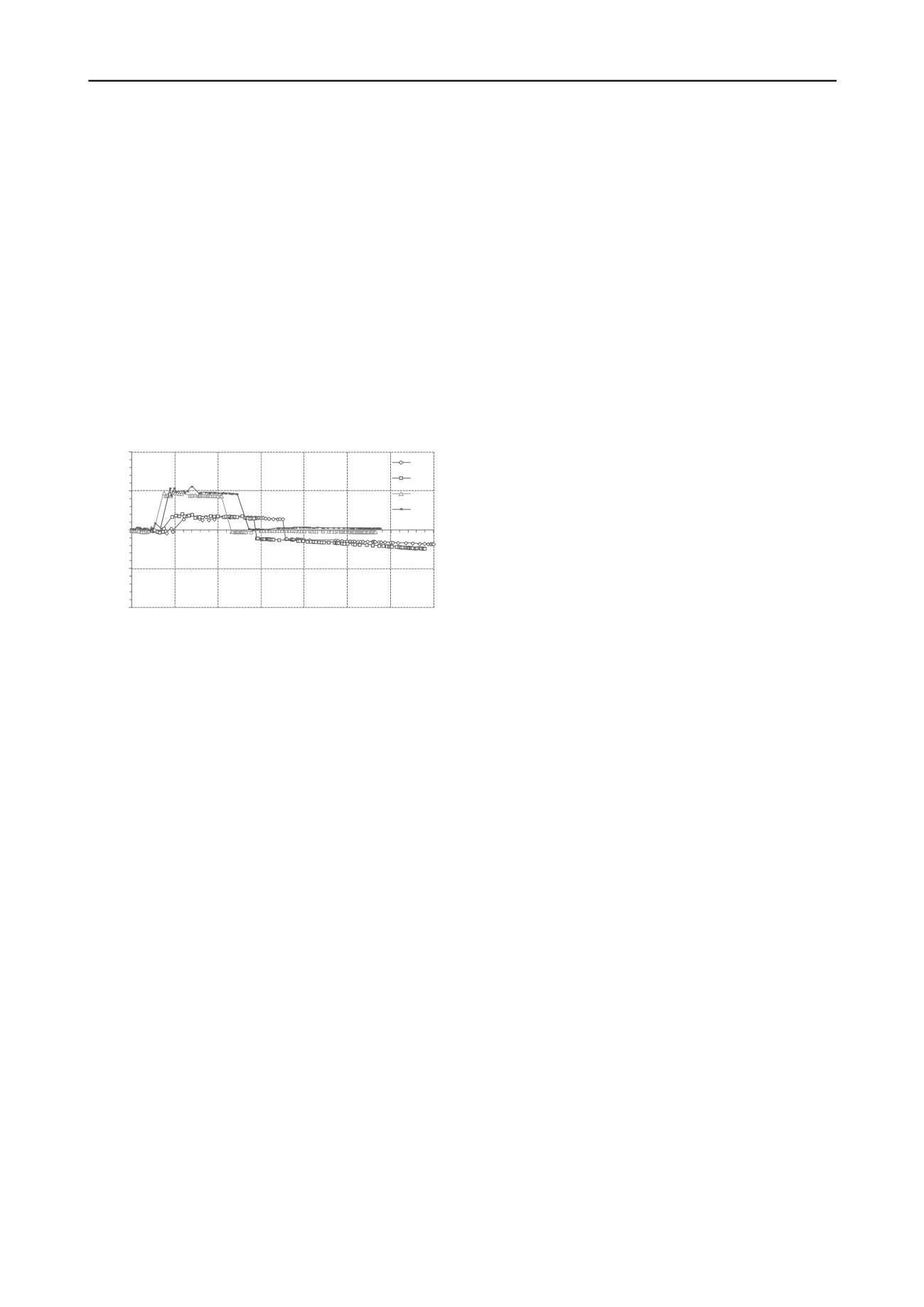
2196
Proceedings of the 18
th
International Conference on Soil Mechanics and Geotechnical Engineering, Paris 2013
into account the sloping surface geometry and the kinematic
conditions of the adjacent southwest slopes.
The southwest slopes can be considered in a regressive
moving condition as well. The movement there occurs at a very
deep seated slip surface which is, partly formed on the schist
bedrock probably on top of an old “inactive” fault and partly on
the Neogene formation. The movement of that deeper slide may
be generating lateral forces that are applied on the moving mass
at the southeast mine slopes.
The complex movement of the southeast slope is also
affected by the inclination of the sliding surface where the
southeast slopes are moving on. As was shown previously in
section A-A’ the shear surface was found to have an
unfavorable inclination of about 4-5
o
. This unfavorable situation
is not continuous transversely across the slope. This can be
safely stipulated after careful evaluation of the vertical –
horizontal displacement of different prisms in the same bench
(figure 9). In this plot the abrupt change of measurements is due
to maintenance of the prisms.
‐1000
‐500
0
500
1000
0
500
1000
1500
2000
2500
3000
3500
dZ (mm)
Cumulative Vector XY (mm)
4A1
4A2
4A3
4A4
Figure 9. Vertical versus horizontal displacement
As can be seen from figure 9 and especially after about
1500mm of horizontal displacement, when no abrupt changes
are recorded, the prisms at the east (4A1, 4A2) produce a
downward movement with an angle of about 4-5
o
. The 4A2
prism which is located at cross section A-A’ produces the same
shear surface inclination as determined by the inclinometers.
Further to the west the sliding surface becomes horizontal or
even with slight favorable inclination. This sliding surface
geometry is responsible for the increased movement to the east
and the rotation of the moving mass.
This detailed evaluation of the moving mass could not be
possible without the dense grid of measuring points and the
high accuracy of the robotic total station. It is evident that with
accurate monitoring data shear surface inclinations can be
evaluated from surface measurements.
6 CONCLUSIONS
A case study of high horizontal movements recorded on
operational surface mine slopes has been presented. The slopes
have been moving with an average velocity of about 10-
20mm/day and until today they have moved more than 3m.
The sliding mechanism was investigated and, based on back-
analysis, it was determined that the southeast slopes of the mine
are moving on top of a near horizontal shear surface with a
residual friction angle of about 7
o
. As no water pore pressure
was used in the analysis, this value is considered a lower bound,
and coincides with values determined through lab experiments
for similar material in the mine area. The slope stability analysis
is considered only indicative due to the complex geometry of
the moving mass. It is not possible to exactly model this mass
with plain strain limit equilibrium methods.
Great emphasis was given in the monitoring program in
which twenty prisms, two inclinometers and two piezometers
were used. The surface monitoring of the prisms was greatly
enhanced when a high accuracy robotic total station was used.
With the high accuracy of the robotic total station, movement
vectors could easily and accurately be measured.
The measurements presented a complex type of movement
of the slopes which most of the time was of the regressive type.
The slope movement has been found to be greatly affected by
the periodic precipitation and the infilling of the tension cracks.
Based on the regressive type of movement, the mining
operation could continue and at the same time remedial
measures taken with excavation of the top benches for
unloading. This remediation decreased but did not stop slope
movements. Although the slopes have moved more than 3m
horizontally, they are still in operation without significant
problems. Movements were found to be very sensitive to
external conditions such as precipitation.
The increased accuracy of the prism measurements allowed
the identification of the sliding surface inclination along the
mine slopes. It was found that the sliding surface changed
inclination transversely.
High mine slopes can be in operation even if they produce
high rates of movement, as long as the sliding mechanism type
is identified and continuously monitored. Remedial measures
can be incorporated in the mine plan in order to reduce
movements.
REFERENCES
ASTM D2487-98.
Standard Practice for Classification of Soils for
Engineering Purposes (Unified Soil Classification System).
American Society for Testing and Materials.
Diamantopoulos, A., 2006.
Plio-Quaternary Geometry and Kinematics
of Ptolemais Basin (Northern Greece): Implications for the Intral-
Plate Tectonics in Western Macedonia.
Geologia Croatica, 59/1,
Zagreb.
Rose, N.D, Hungr, O., 2007.
Forecasting potential rock slope failure in
open pit mines using the inverse-velocity method.
International
Journal of Rock Mechanics & Mining Sciences, Vol. 44, pp. 308-
320.
Ryan, T. M. & Call, R. D., 1992.
Applications of rock mass monitoring
for stability assessment of pit slope failures.
Rock Mechanics,
Tillerson & Wawersik (eds), Balkema, Rotterdam.
Sullivan, T. D., 2007.
Hydromechanical Coupling and Pit Slope
Movements.
Slope Stability 2007, Potvin (ed), Australian Center for
Geomechanics, Perth
Zavodni, Z. M. and Broadbent, C. D., 1980.
Slope failure kinematics.
CIM Bulleting, Vol. 73, No. 816.
Zavodni, Z. M., 2000.
Time-Dependent Movement of Open-Pit Slopes.
Chapter 8, Slope stability in surface mining, Hustrulid, McCarter,
VanZyl (eds), Society for Mining, Metallurgy and Exploration.


